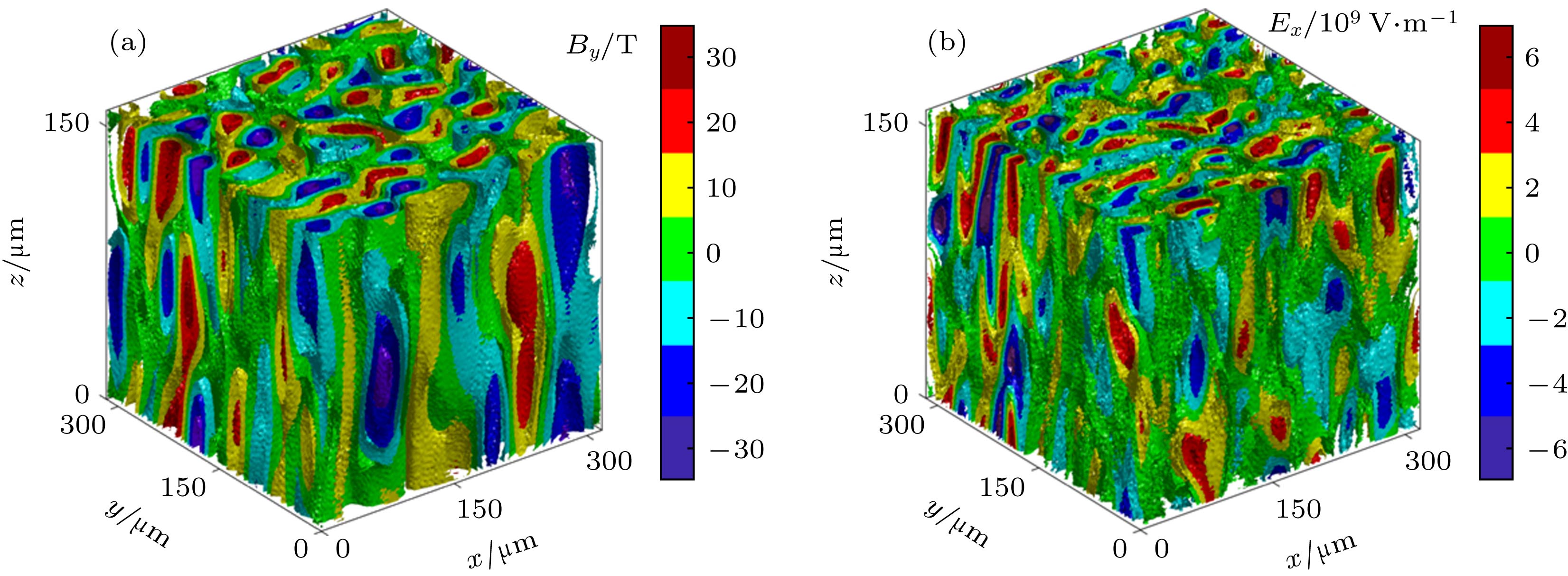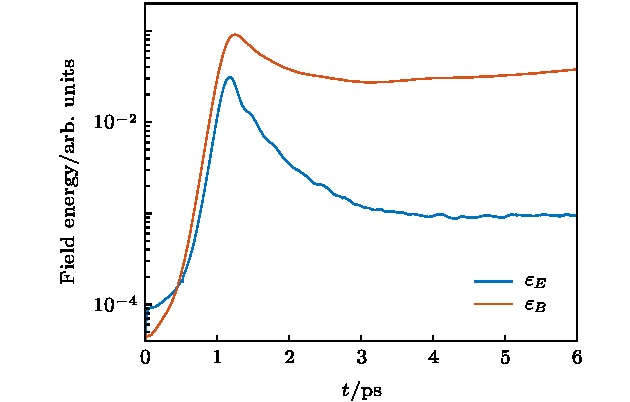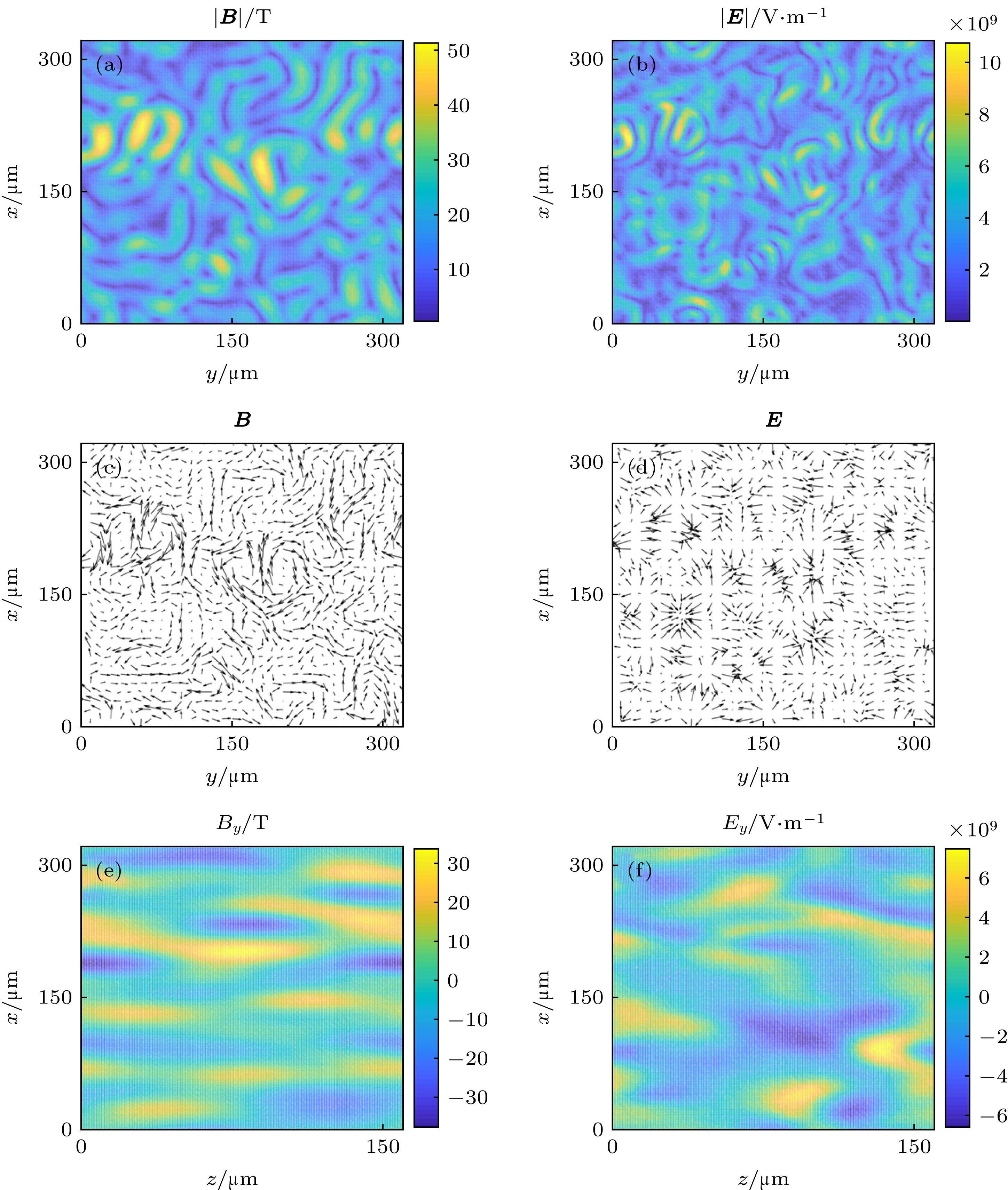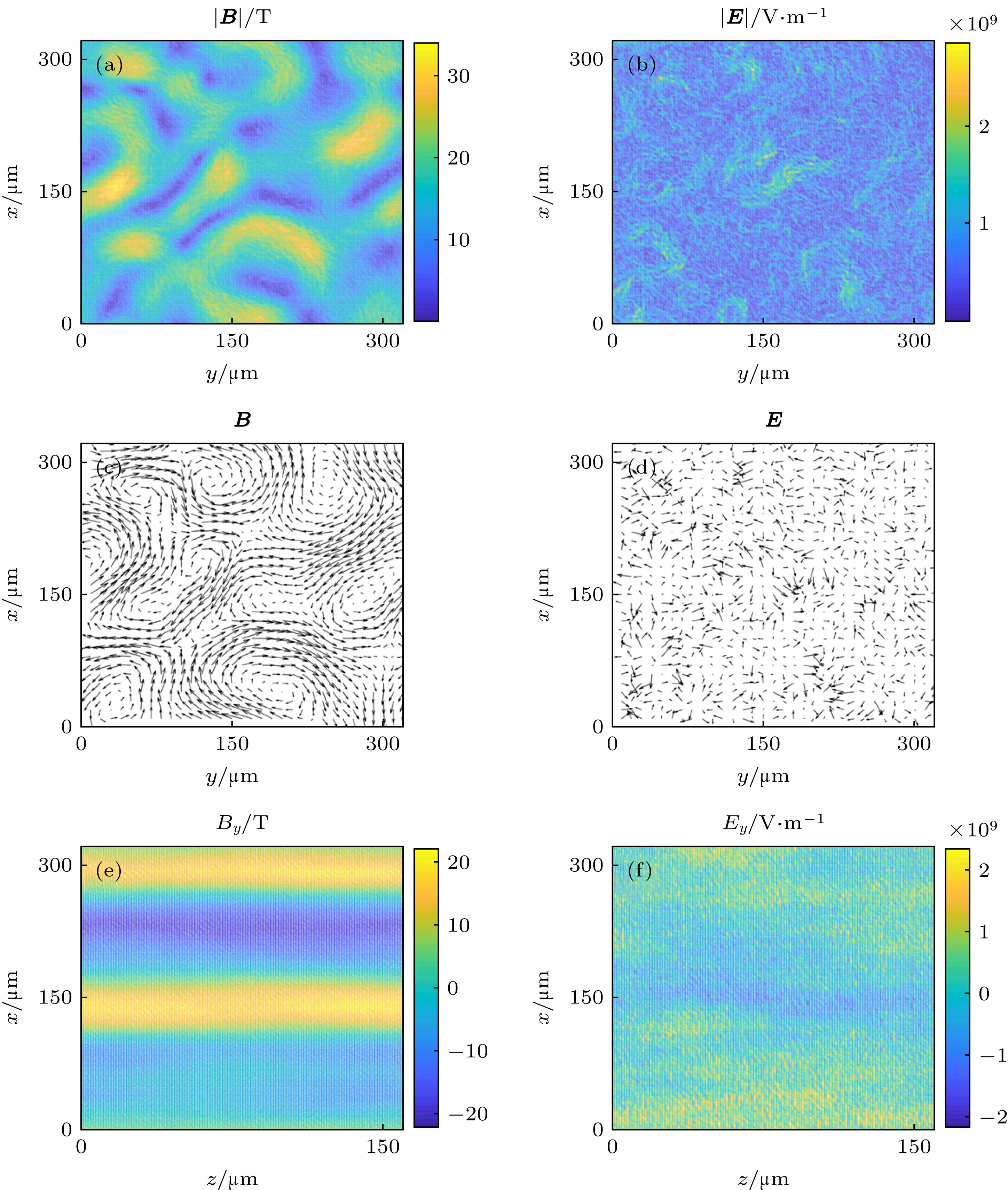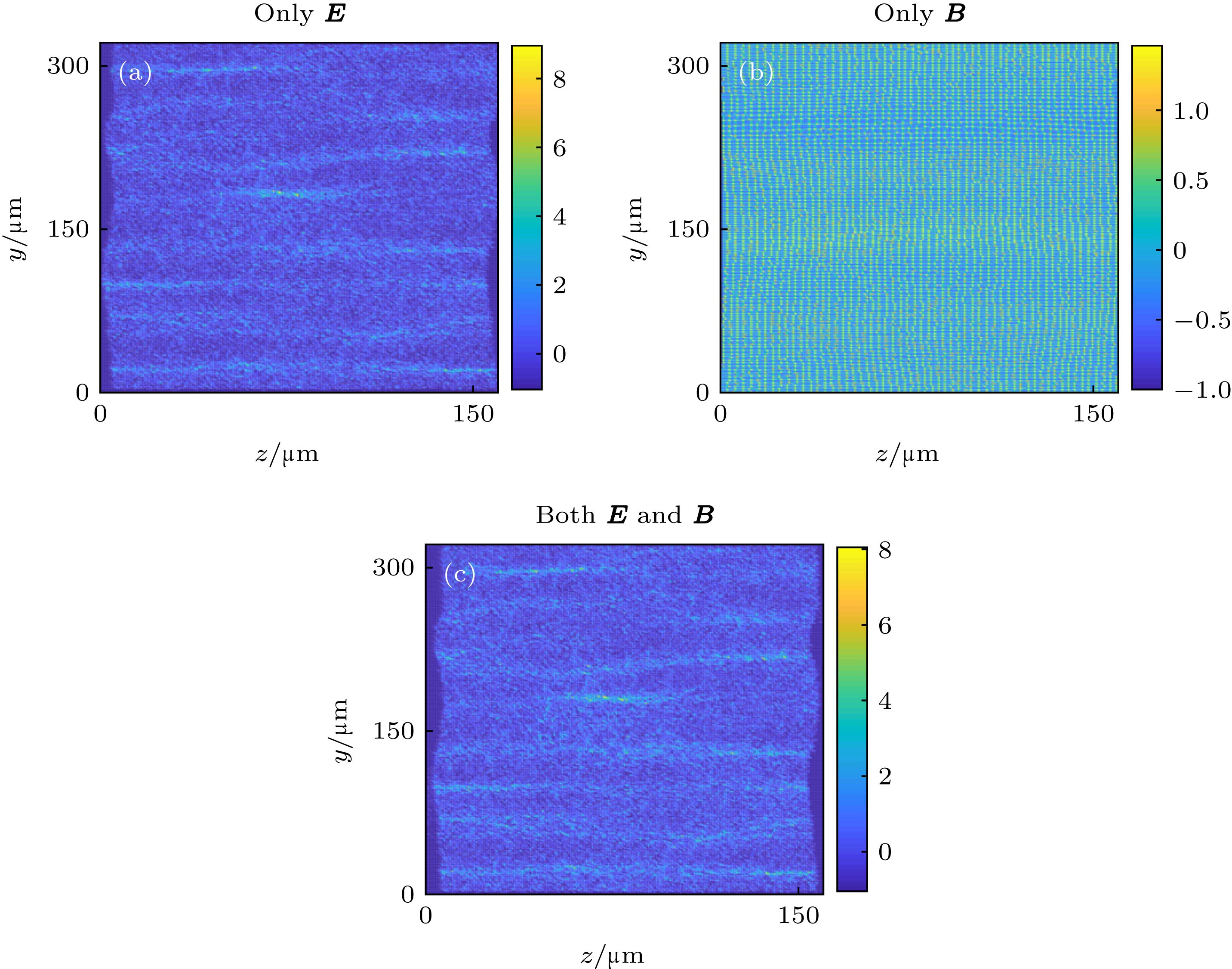-
Weibel不稳定性的自生电磁场对于等离子体能量输运、无碰撞冲击波形成等物理过程具有关键的影响. 实验上往往采用质子束照相来诊断其电磁场结构. 一般认为, 探针质子束的轨迹偏转主要来自于磁场, 而自生电场的作用被认为可忽略不计. 本文利用三维粒子模拟程序研究了典型参数下的Weibel不稳定性发展过程, 并使用径迹追踪法评估了Weibel不稳定性的质子束照相过程中电场和磁场对探针质子束的偏转作用. 对比分析发现, 引起探针质子束偏转的主要因素并不是磁场, 而是过去研究中常被忽略的电场. 主要原因为: Weibel不稳定性的自生磁场往往成管状结构, 在使用探针质子束对其进行侧向照相时, 磁场的作用会被自身中和并抵消. 该认识将有助于深入理解Weibel不稳定性质子照相的实验结果.
-
关键词:
- Weibel不稳定性 /
- 质子束照相 /
- 电磁场诊断 /
- 粒子模拟
The electric and magnetic fields generated by the Weibel instability, most of which have a tube-like structure, are of importance for many relevant physical processes in the astrophysics and the inertial confinement fusion. Experimentally, proton radiography is a commonly used method to diagnose the Weibel instability, where the proton deflection introduced from the self-generated electric field is usually ignored. This assumption, however, is in conflict with the experimental observations by Quinn, Fox and Huntington, et al. because the magnetic field with a tube-like structure cannot introduce parallel flux striations on the deflection plane in the proton radiography. In this paper, we re-examine the nature of the proton radiography of the Weibel instability numerically. Two symmetric counterstreaming plasma flows are used to generate the electron Weibel instability with the three-dimensional particle-in-cell simulations. The proton radiography of the Weibel instability generated electric and magnetic fields are calculated with the ray tracing method. Three cases are considered andcompared: only the self-generated electric field E is included, only the self-generated magnetic field B is included, both the electric field E and magnetic field B are included. It is shown that when only E is included, the probe proton flux density perturbation on the detection plane, i.e., δn/n0, is much larger than that when only B is included. Also, when both E and B are included, δn/n0 is almost the same as that when only E is included. This suggests that in the proton radiography of the Weibel instability generated electric and magnetic fields, the deflection from the electric field dominates the radiography, whereas the magnetic field has an ignorable influence. Our conclusion is quite different from that obtained on the traditional assumption that the electric field is ignorable in the radiography. This mainly comes from the spatial structure of the Weibel instability generated magnetic field, which is tube-like and points to the azimuthal direction around the current filaments. When the probe protons pass through the field region, the deflection from the azimuthal magnetic field can be compensated for completely by itself along the passing trajectories especially if the deflection distance inside the field region is small. Whereas for the electric field, which is in the radial direction, the deflection to the probe protons will not be totally compensated for and will finally introduce an evident flux density perturbation into the detection plane. This understanding can beconducive to the comprehension of the experimental results about the proton radiography of the Weibel instability. -
Keywords:
- Weibel instability /
- proton radiography /
- electric and magnetic diagnostics /
- particle-in-cell simulations
[1] Weibel E S 1959 Phys. Rev. Lett. 2 83
 Google Scholar
Google Scholar
[2] Fried B D 1959 Phys. Fluids 2 337
[3] Honda M, Meyer-ter-Vehn J, Pukhov A 2000 Phys. Rev. Lett. 85 2128
 Google Scholar
Google Scholar
[4] Ross J S, Park H S, Berger R, Divol L, Kugland N L, Rozmus W, Ryutov D, Glenzer S H 2013 Phys. Rev. Lett. 110 145005
 Google Scholar
Google Scholar
[5] Fiuza F, Fonseca R A, Tonge J, Mori W B, Silva L O1 2012 Phys. Rev. Lett. 108 235004
 Google Scholar
Google Scholar
[6] Ardaneh K, Cai D S, Nishikawa K I, Lembége B 2015 Astrophys. J. 811 57
 Google Scholar
Google Scholar
[7] Quinn K, Romagnani L, Ramakrishna B, Sarri G, Dieckmann M E, Wilson P A, Fuchs J, Lancia L, Pipahl A, Toncian T, Willi O, Clarke R J, Notley M, Macchi A, Borghesi M 2012 Phys. Rev. Lett. 108 135001
 Google Scholar
Google Scholar
[8] Kugland N L, Ryutov D D, Chang P Y, Drake R P, Fiksel G, Froula D H, Glenzer S H, Gregori G, Grosskopf M, Koenig M, Kuramitsu Y, Kuranz C, Levy M C, Liang E, Meinecke J, Miniati F, Morita T, Pelka A, Plechaty C, Presura R, Ravasio A, Remington B A, Reville B, Ross J S, Sakawa Y, Spitkovsky A, Takabe H, Park H S 2012 Nat. Phys. 8 809
 Google Scholar
Google Scholar
[9] Fox W, Fiksel G, Bhattacharjee A, Chang P Y, Germaschewski K, Hu S X, Nilson P M 2013 Phys. Rev. Lett. 111 225002
 Google Scholar
Google Scholar
[10] Huntington C M, Fiuza F, Ross J S, Zylstra A B, Drake R P, Froula D H, Gregori G, Kugland N L, Kuranz C C, Levy M C, Li C K, Meinecke J, Morita T, Petrasso R, Plechaty C, Remington B A, Ryutov D D, SakawaY, Spitkovsky A, Takabe H, Park S H 2015 Nat. Phys. 11 173
 Google Scholar
Google Scholar
[11] Tzoufras M, Ren C, Tsung F S, Tonge J W, Mori W B, Fiore M, Fonseca R A, Silva L O 2006 Phys. Rev. Lett. 96 105002
 Google Scholar
Google Scholar
[12] Dieckmann M E 2009 Plasma Phys. Control. Fusion 51 124042
 Google Scholar
Google Scholar
[13] Kugland N L, Ryutov D D, Plechaty C, Ross J S, Park H S 2012 Rev. Sci. Instruments 83 101301
 Google Scholar
Google Scholar
[14] Wang W W, Cai H B, Teng J, Chen J, He S K, Shan L Q, Lu F, Wu Y C, Zhang B, Hong W, Bi B, Zhang F, Liu D X, Xue F B, Li B Y, Liu H J, He W, Jiao J L, Dong K G, Zhang F Q, He Y L, Cui B, Xie N, Yuan Z Q, Tian C, Wang X D, Zhou K N, Deng Z G, Zhang Z M, Zhou W M, Cao L F, Zhang B H, Zhu S P, He X T, Gu Y Q 2018 Phys. Plasmas 25 083111
 Google Scholar
Google Scholar
[15] Bret A, Gremillet L, Dieckmann M E 2010 Phys. Plasmas 17 120501
 Google Scholar
Google Scholar
[16] Gao L, Nilson M P, Igumenshchev I V, Haines M G, Froula D H, Betti R, Meyerhofer D D 2015 Phys. Rev. Lett. 114 215003
 Google Scholar
Google Scholar
[17] Du B, Wang X F 2018 AIP Adv. 8 125328
 Google Scholar
Google Scholar
[18] Cai H B, Mima K, Zhou W M, Jozaki T, Nagatomo H, Sunahara A, Mason R J 2009 Phys. Rev. Lett. 102 245001
 Google Scholar
Google Scholar
[19] Cagas P, Hakim A, Scales W, Srinivasan B 2017 Phys. Plasmas 24 112116
 Google Scholar
Google Scholar
[20] Alves E P, Zrake J, Fiuza F 2018 Phys. Rev. Lett. 121 245101
 Google Scholar
Google Scholar
[21] Sentoku Y, Mima K, Sheng Z M, Kaw P, Nishihara K, Nishikawa K 2002 Phys. Rev. E 65 046408
 Google Scholar
Google Scholar
[22] Shukla C, Kumar A, Das A, Patel B G 2018 Phys. Plasmas 25 022123
 Google Scholar
Google Scholar
[23] Li C K, Séguin F H, Frenje J A, Rygg J R, Petrasso R D, Town R P J, Amendt P A, Hatchett S P, Landen O L, Mackinnon A J, Patel P K, Smalyuk V A, Sangster T C, Knauer J P 2006 Phys. Rev. Lett. 97 135003
 Google Scholar
Google Scholar
[24] Cecchetti C A, Borghesi M, Fuchs J, Schurtz G, Kar S, Macchi A, Romagnani, Wilson P A, Antici P, Jung R, Osterholtz J, Pipahl C, Willi O, Schiavi A, Notley M, Neely D 2009 Phys. Plasmas 16 043102
 Google Scholar
Google Scholar
-
图 4 t = 1.06 ps时, z = 0平面上(a)磁场强度|B|、(b)电场强度|E|、(c)磁场方向和(d)电场方向的分布情况以及y = 0平面上(e) y向磁场By和(f) y向电场Ey的分布情况
Fig. 4. Spatial distributions of (a) the magnetic field strength |B|, (b) the electric field strength |E|, (c) the direction of B and (d) the direction of E on the z = 0 plane, (e) the y component of the magnetic field By and (f) the y component of the electric field Ey on the y = 0 plane at t = 1.06 ps.
图 5 t = 4.78 ps时, z = 0平面上(a)磁场强度|B|、(b)电场强度|E|、(c)磁场方向和(d)电场方向的分布情况以及y = 0平面上(e) y向磁场By和(f) y向电场Ey的分布情况
Fig. 5. Spatial distributions of (a) the magnetic field strength |B|, (b) the electric field strength |E|, (c) the direction of B and (d) the direction of E on the z = 0 plane, (e) the y component of the magnetic field By and (f) the y component of the electric field Ey on the y = 0 plane at t = 4.78 ps.
图 6 t = 1.06 ps时, (a)只考虑电场E、(b)只考虑磁场B以及(c)同时考虑电场E和磁场B三种情况下探测面上的质子通量密度扰动分布信息
Fig. 6. Proton flux density perturbations on the detection plane when (a) only the electric field is included, (b) only the magnetic field is included and (c) both the electric and magnetic fields are included at t = 1.06 ps.
-
[1] Weibel E S 1959 Phys. Rev. Lett. 2 83
 Google Scholar
Google Scholar
[2] Fried B D 1959 Phys. Fluids 2 337
[3] Honda M, Meyer-ter-Vehn J, Pukhov A 2000 Phys. Rev. Lett. 85 2128
 Google Scholar
Google Scholar
[4] Ross J S, Park H S, Berger R, Divol L, Kugland N L, Rozmus W, Ryutov D, Glenzer S H 2013 Phys. Rev. Lett. 110 145005
 Google Scholar
Google Scholar
[5] Fiuza F, Fonseca R A, Tonge J, Mori W B, Silva L O1 2012 Phys. Rev. Lett. 108 235004
 Google Scholar
Google Scholar
[6] Ardaneh K, Cai D S, Nishikawa K I, Lembége B 2015 Astrophys. J. 811 57
 Google Scholar
Google Scholar
[7] Quinn K, Romagnani L, Ramakrishna B, Sarri G, Dieckmann M E, Wilson P A, Fuchs J, Lancia L, Pipahl A, Toncian T, Willi O, Clarke R J, Notley M, Macchi A, Borghesi M 2012 Phys. Rev. Lett. 108 135001
 Google Scholar
Google Scholar
[8] Kugland N L, Ryutov D D, Chang P Y, Drake R P, Fiksel G, Froula D H, Glenzer S H, Gregori G, Grosskopf M, Koenig M, Kuramitsu Y, Kuranz C, Levy M C, Liang E, Meinecke J, Miniati F, Morita T, Pelka A, Plechaty C, Presura R, Ravasio A, Remington B A, Reville B, Ross J S, Sakawa Y, Spitkovsky A, Takabe H, Park H S 2012 Nat. Phys. 8 809
 Google Scholar
Google Scholar
[9] Fox W, Fiksel G, Bhattacharjee A, Chang P Y, Germaschewski K, Hu S X, Nilson P M 2013 Phys. Rev. Lett. 111 225002
 Google Scholar
Google Scholar
[10] Huntington C M, Fiuza F, Ross J S, Zylstra A B, Drake R P, Froula D H, Gregori G, Kugland N L, Kuranz C C, Levy M C, Li C K, Meinecke J, Morita T, Petrasso R, Plechaty C, Remington B A, Ryutov D D, SakawaY, Spitkovsky A, Takabe H, Park S H 2015 Nat. Phys. 11 173
 Google Scholar
Google Scholar
[11] Tzoufras M, Ren C, Tsung F S, Tonge J W, Mori W B, Fiore M, Fonseca R A, Silva L O 2006 Phys. Rev. Lett. 96 105002
 Google Scholar
Google Scholar
[12] Dieckmann M E 2009 Plasma Phys. Control. Fusion 51 124042
 Google Scholar
Google Scholar
[13] Kugland N L, Ryutov D D, Plechaty C, Ross J S, Park H S 2012 Rev. Sci. Instruments 83 101301
 Google Scholar
Google Scholar
[14] Wang W W, Cai H B, Teng J, Chen J, He S K, Shan L Q, Lu F, Wu Y C, Zhang B, Hong W, Bi B, Zhang F, Liu D X, Xue F B, Li B Y, Liu H J, He W, Jiao J L, Dong K G, Zhang F Q, He Y L, Cui B, Xie N, Yuan Z Q, Tian C, Wang X D, Zhou K N, Deng Z G, Zhang Z M, Zhou W M, Cao L F, Zhang B H, Zhu S P, He X T, Gu Y Q 2018 Phys. Plasmas 25 083111
 Google Scholar
Google Scholar
[15] Bret A, Gremillet L, Dieckmann M E 2010 Phys. Plasmas 17 120501
 Google Scholar
Google Scholar
[16] Gao L, Nilson M P, Igumenshchev I V, Haines M G, Froula D H, Betti R, Meyerhofer D D 2015 Phys. Rev. Lett. 114 215003
 Google Scholar
Google Scholar
[17] Du B, Wang X F 2018 AIP Adv. 8 125328
 Google Scholar
Google Scholar
[18] Cai H B, Mima K, Zhou W M, Jozaki T, Nagatomo H, Sunahara A, Mason R J 2009 Phys. Rev. Lett. 102 245001
 Google Scholar
Google Scholar
[19] Cagas P, Hakim A, Scales W, Srinivasan B 2017 Phys. Plasmas 24 112116
 Google Scholar
Google Scholar
[20] Alves E P, Zrake J, Fiuza F 2018 Phys. Rev. Lett. 121 245101
 Google Scholar
Google Scholar
[21] Sentoku Y, Mima K, Sheng Z M, Kaw P, Nishihara K, Nishikawa K 2002 Phys. Rev. E 65 046408
 Google Scholar
Google Scholar
[22] Shukla C, Kumar A, Das A, Patel B G 2018 Phys. Plasmas 25 022123
 Google Scholar
Google Scholar
[23] Li C K, Séguin F H, Frenje J A, Rygg J R, Petrasso R D, Town R P J, Amendt P A, Hatchett S P, Landen O L, Mackinnon A J, Patel P K, Smalyuk V A, Sangster T C, Knauer J P 2006 Phys. Rev. Lett. 97 135003
 Google Scholar
Google Scholar
[24] Cecchetti C A, Borghesi M, Fuchs J, Schurtz G, Kar S, Macchi A, Romagnani, Wilson P A, Antici P, Jung R, Osterholtz J, Pipahl C, Willi O, Schiavi A, Notley M, Neely D 2009 Phys. Plasmas 16 043102
 Google Scholar
Google Scholar
计量
- 文章访问数: 12651
- PDF下载量: 98
- 被引次数: 0













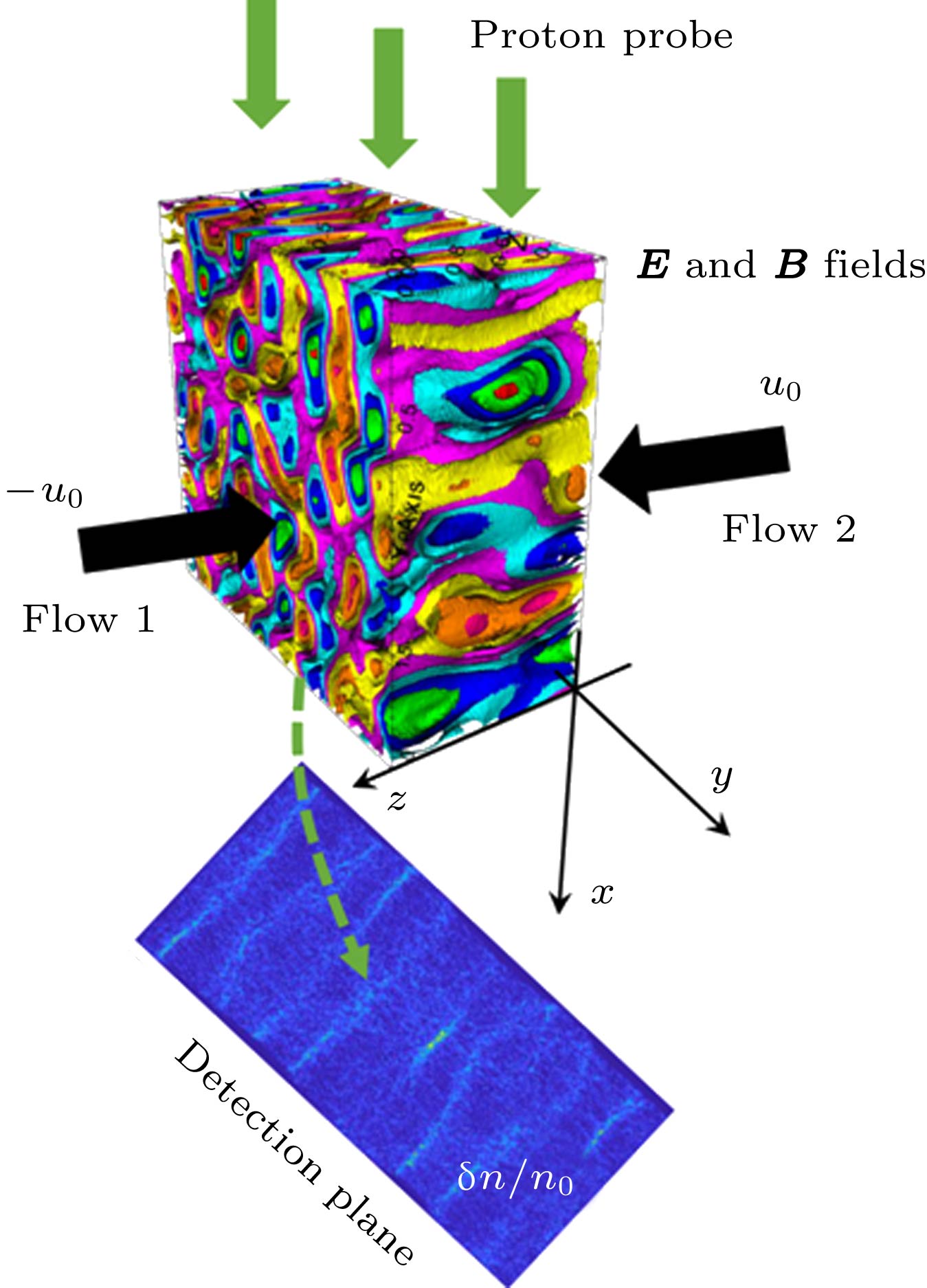
 下载:
下载:
